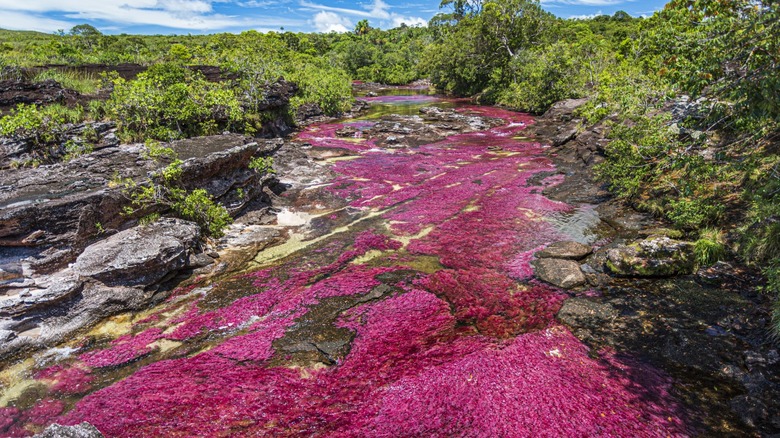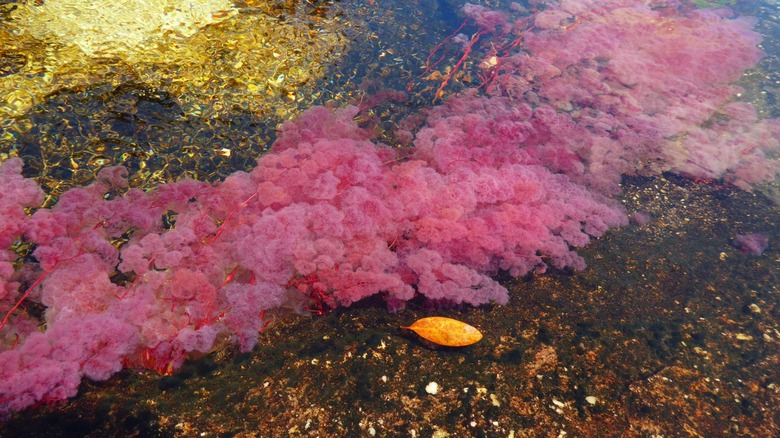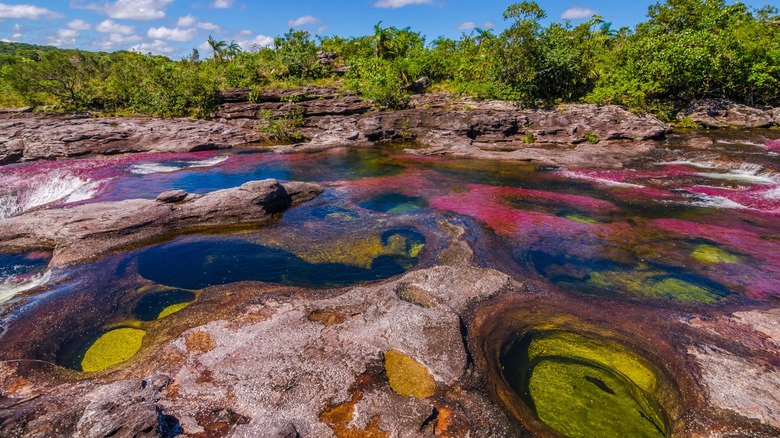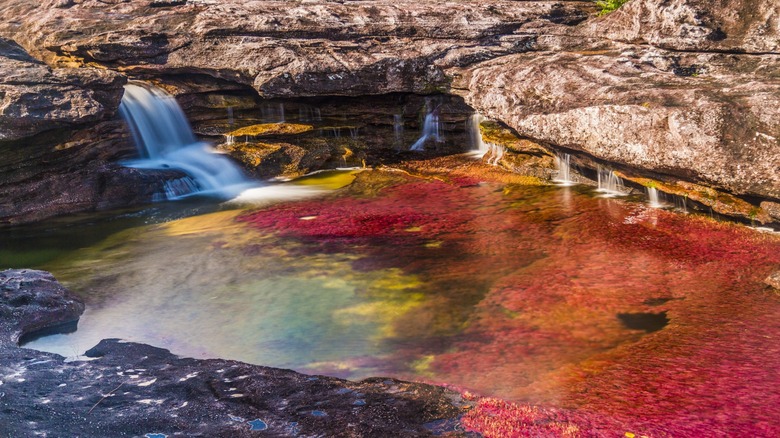The Fascinating Science Behind The Gorgeous River Of Five Colors In Colombia
When it comes to natural beauty, not many other bodies of water can compare with Colombia's Caño Cristales or the "river of five colors." Located a little over 100 miles south of Bogotá, this rare, naturally occurring phenomenon causes the river's crystal-clear water to light up in a wild array of beautiful rainbow colors during a specific time of the year.
Throughout most of the year, while still a naturally beautiful area with some of the most gorgeous waterfalls in the world, the green mosses make Caño Cristales appear like a relatively normal lake. However, the lake lights up from May to November, displaying a stunning array of natural colors, giving the lake its nickname, "liquid rainbow."
While you wouldn't be alone in thinking that something unnatural must be occurring in Caño Cristales to create the vibrant hues, you may be surprised to learn that scientists have studied the river and discovered that the rainbow effect is a result of a rare phenomenon found nowhere else on Earth.
The science behind the rainbow colors of Caño Cristales
The river of five colors, or Caño Cristales, gets its unique rainbow pigmentation from an aquatic plant known as the macarenia clavigera. Colors in the 62.1-mile river range from red, yellow, purple, pink, and blue and are determined by sunlight, temperature, and rainfall. Located on the verdant, bio-diverse geological formation known as the Guiana Shield, stretches of Caño Cristales change color during each new season depending on the weather conditions.
The Guiana Shield is a one-of-a-kind bio-diverse location where the Andes, Amazon rainforests, and Easter Llanos converge. Believed to have been formed 1.7 billion years ago by ancient rivers rich in minerals like phosphorous, quartz, and iron, Caño Cristales is the only place on Earth where macarenia clavigera grows and, thus, the only place to possess its unique kaleidoscopic effect. Like the Northern Lights (aurora borealis) or colorful nacreous clouds, the river of five colors possesses such a beautiful look as a result of highly specific conditions in nature.
In addition to possessing a vibrant hue of colors across the spectrum, the river also has noteworthy circular rock pools where large holes in rock formations cause water to rush through them. Today, people can visit the Parque Nacional Natural Serranía de La Macarena and get a tour of the river with companies found in the small town of La Macarena.
Caño Cristales has a long and facinating history
Caño Cristales holds a long history and significance to the indigenous locals who live in the area but was more recently "re-discovered" in 1989 when journalist Andrés Hurtado García hiked for several hours to snap a picture of the river. While local legends and beliefs around the river are somewhat mysterious, some claim legends believe that the river escaped paradise and wandered across the mountains and prairies before making its final home in Colombia.
However, unfortunately, the cultural significance and the rare biodiversity of the river of five colors don't make it immune to crime and war. From 1989 to 2009, the area around the river was closed to the public due to the ongoing conflict between the Colombian government and drug cartels. In 2016, peace deals with the cartels enabled the country to reopen the area to tourists and locals who wanted to share a glimpse of the river.
For a short time after that, tourists were allowed to view the river, but in 2020, FARC guerrillas threatened the area again, setting parts of it ablaze. Most recently, the Colombian government reached an agreement and ceasefire in May of 2023 with an offshoot of the organization known as EMC-FARC, according to the BBC.
Caño Cristales may be under threat
According to a New York Times interview with people living in La Macarena, seasonal change is occurring, potentially due to climate change, causing the rainbow effect of Caño Cristales to arrive earlier each year. In addition, Hupecol, an oil and gas company, started exploratory drilling campaigns in Colombia's Llanos basin as recently as May 2022 on behalf of Houston American Energy Corp. As one of the unique bio-diverse regions helping form the area around Caño Cristales, scientists fear the drilling could potentially impact many unique species of animals and plants in the area, including the macarenia clavigera.
Potential oil drilling isn't the only thing that puts Caño Cristales and the verdant lands around it at potential risk, however. In an interview with CNN, Carlos Lasso, a senior researcher at Humboldt Institute, said, "The region of the Serranía de la Macarena has been a place of war for many years ... [but now] deforestation in the region is advancing at an alarming rate." In addition to impacting the species of animals that make the land so unique, deforestation also affects rainfall patterns, which could lead to negative effects on the macarenia clavigera that grows there.
While only time will tell whether the Colombian government will help protect the area and its inhabitants from the potentially negative effects of oil drilling, deforestation, and guerilla groups, the area in and around Caño Cristales will hopefully be preserved so that future generations can behold its wonderful natural beauty.



